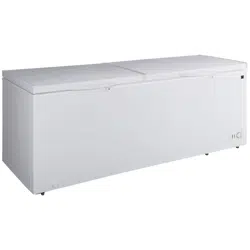Loading ...
Loading ...
Loading ...

CLEANING
DEFROST
CLEANING & MAINTENANCE
Please clean the dust behind and around the freezer frequently to improve heat
dissipation and save energy.
Regularly inspect the door seal to ensure it is clean and free of debris. Clean
the door seal with a soft cloth dipped in soapy water or diluted cleaning agent.
The interior of the freezer should be regularly cleaned to avoid odor.
Before cleaning the interior of the freezer, please turn the power off, take out
all the food, hanging baskets and containers.
Use a soft cloth or sponge to clean the inner liner of the freezer. You can use two tablespoons of baking soda and
one quart of warm water solution to clean it first, then rinse it with clean water, then wipe it clean. After cleaning,
leave the door open and let it dry naturally before connecting to the power supply.
For areas inside the freezer that are not easy to clean (e.g. gaps or corners), it is recommended to use soft cloths,
soft brushes, etc. and some necessary aids (e.g. thin sticks, etc.) to carry out regular cleaning to ensure that there
are no accumulation of pollutants or bacteria.
Do not use soaps, detergents, spray cleaners, etc. to clean the liner as these may create odors or contamination.
Clean the hanging basket with a soft cloth dipped in soapy water or diluted cleaning agent, then dry it with a soft
cloth or air dry naturally.
Wipe the outside surface of the freezer with a soft cloth moistened with soapy water, detergent, etc., then dry with
a soft cloth.
Do not use hard hairbrush, steel wire ball, steel wire brush, abrasive (such as toothpaste), organic solvent (such as
alcohol, acetone, isoamyl acetate, etc.), boiling water, or acidic or alkaline substances during cleaning, as it may
damage the surface and inner liner of the freezer. Organic solvents such as boiling water and benzene may deform
or damage plastic parts.
Do not rinse directly with water or other liquids during cleaning to avoid short circuit or affecting electrical
insulation performance after soaking.
Freezers need to be manually defrosted. When defrosting, please unplug the power plug first, open the freezer
door, and take out indoor food, hanging baskets, etc.; Open the drain hole and outlet hole (and place a water
container at the outlet hole) to allow the indoor ice and frost to naturally melt, and dry the defrosting water with
a dry soft cloth. Once the frost softens, you can use an ice shovel to speed up deicing.
When defrosting, please keep the removed food in a cool place before removing the accessories.
When defrosting and cleaning the freezer, unplug the power supply first.
Do not use mechanical devices or other means of acceleration
other than those recommended by the manufacturer.
The refrigeration circuit must not be damaged.
Once the freezer is activated, it is best to use it continuously, and under normal
circumstances, do not stop using the freezer, so as not to affect the service life.
WHEN NOT IN USE
POWER INTERRUPTIONS - Even in the summer, food can still be stored for several hours. During this period,
the number of opening door should be reduced, and fresh food should not be added. If outage is for a prolonged
period, inspect and discard spoiled or thawed food in freezer. Clean freezer before reusing.
LONG ABSENCES - Empty the freezer completely and unplug the power cord. Clean and dry the interior thoroughly.
To prevent odor and mold growth, leave the door slightly open.
MOVING - Do not invert, transport horizontally, or vibrate the freezer during transportation. The tilt angle during
transportation should not exceed 45°. Do not grab the door or hinge while moving.
10
Loading ...
Loading ...
Loading ...
